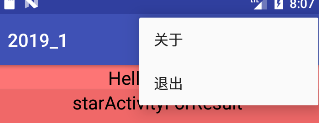Google Android SDK开发范例大全笔记 一
方法讲解
1 获取手机分辨率方法 DisplayMetrics
private void getDiaplayMetrics() { DisplayMetrics dm = new DisplayMetrics(); getWindowManager().getDefaultDisplay().getMetrics(dm); String strMetrics = "手机分辨率为:"+dm.widthPixels+" * "+dm.heightPixels; String strdm =" 手机屏幕信息:" + dm.toString(); Log.d("panzqww",strMetrics); Log.d("panzqww",strdm); }
结果
手机分辨率为:720 * 1280
手机屏幕信息:DisplayMetrics{density=2.0, width=720, height=1280, scaledDensity=2.0, xdpi=320.0, ydpi=320.0}
2 startActivityForResult 方法
- MainActivity中执行跳转到Activity_b
Intent intent = new Intent(MainActivity.this,Activity_b.class); startActivityForResult(intent,REQUEST_CODE);
- Activity_b中执行 将Activity_b finish掉返回到MainActivity
Intent intent = new Intent(); intent.putExtra("result","来自Activity b"); Activity_b.this.setResult(RESULT_CODE,intent); Activity_b.this.finish();
- MainActivity中onActivityResult接收到返回的数据
@Override protected void onActivityResult(int requestCode, int resultCode, @Nullable Intent data) { super.onActivityResult(requestCode, resultCode, data); if(data !=null) { String result = data.getExtras().getString("result"); Log.d("panzqww","requestCode = " + requestCode + ", resultCode = " + resultCode + " , result = " + result); } }
打印信息
requestCode = 256, resultCode = 512 , result = 来自Activity b
3 解析并获取asset目录下的 ttf字体样式
tv_show.setTypeface(Typeface.createFromAsset(getAssets(), "BinnerD.ttf"));
https://github.com/MichealPan9999/android_sdk_test
4 menu菜单
@Override public boolean onOptionsItemSelected(MenuItem item) { switch (item.getItemId()) { case 0: openOptionDialogAbout(); break; case 1: openOptionDialogExit(); break; } return true; } private void openOptionDialogAbout() { new AlertDialog.Builder(this) .setTitle(R.string.about) .setMessage("版本号 V1.1.8") .setPositiveButton(R.string.confirm , new DialogInterface.OnClickListener() { @Override public void onClick(DialogInterface dialogInterface, int i) { } }).show(); } private void openOptionDialogExit() { new AlertDialog.Builder(this) .setTitle(R.string.exit) .setMessage("确定要退出吗") .setPositiveButton(R.string.yes , new DialogInterface.OnClickListener() { @Override public void onClick(DialogInterface dialogInterface, int i) { finish(); } }) .setNegativeButton(R.string.no, new DialogInterface.OnClickListener() { @Override public void onClick(DialogInterface dialogInterface, int i) { } }).show(); }
执行完以后会在应用右上角出现标志
点击该标志出现两个选项

5 EditText和setTransformationMethod实现密码框显示密码和隐藏密码功能
et_password = findViewById(R.id.et_password); cb_show_hide = findViewById(R.id.cb_show_hide); cb_show_hide.setOnCheckedChangeListener(new CheckBox.OnCheckedChangeListener(){ @Override public void onCheckedChanged(CompoundButton compoundButton, boolean b) { if (cb_show_hide.isChecked()) { et_password.setTransformationMethod(HideReturnsTransformationMethod.getInstance()); cb_show_hide.setText("隐藏密码"); }else{ et_password.setTransformationMethod(PasswordTransformationMethod.getInstance()); cb_show_hide.setText("显示密码"); } } });
6 隐藏是抽屉 SlidingDrawer
public class SlidingDrawerActivity extends AppCompatActivity { private GridView gv; private SlidingDrawer sd; private ImageView im; private int[] icons = {R.drawable.apple_pic,R.drawable.banana_pic,R.drawable.cherry_pic}; private String[] items = {"苹果","香蕉","樱桃"}; @Override protected void onCreate(Bundle savedInstanceState) { super.onCreate(savedInstanceState); setContentView(R.layout.activity_sliding_drawer); gv = findViewById(R.id.gv_myGridView); sd = findViewById(R.id.sd_mySlidingDrawer); im = findViewById(R.id.iv_myImage); MyGridviewAdapter adapter = new MyGridviewAdapter(this,items,icons); gv.setAdapter(adapter); sd.setOnDrawerOpenListener(new OnDrawerOpenListener() { @Override public void onDrawerOpened() { im.setImageResource(R.drawable.open); } }); sd.setOnDrawerCloseListener(new SlidingDrawer.OnDrawerCloseListener() { @Override public void onDrawerClosed() { im.setImageResource(R.drawable.close); } }); }
class MyGridviewAdapter extends BaseAdapter{ private Context mContext; private String[] _items; private int[] _icons; public MyGridviewAdapter(Context mContext, String[] _items, int[] _icons) { this.mContext = mContext; this._items = _items; this._icons = _icons; } @Override public int getCount() { return _items.length; } @Override public Object getItem(int i) { return _items[i]; } @Override public long getItemId(int i) { return i; } @Override public View getView(int i, View view, ViewGroup viewGroup) { LayoutInflater factory = LayoutInflater.from(mContext); View v = factory.inflate(R.layout.grid,null); ImageView iv = v.findViewById(R.id.icon); TextView tv = v.findViewById(R.id.text); iv.setImageResource(_icons[i]); tv.setText(_items[i]); return v; }
布局 activity_sliding_drawer
<?xml version="1.0" encoding="utf-8"?> <LinearLayout xmlns:android="http://schemas.android.com/apk/res/android" xmlns:tools="http://schemas.android.com/tools" android:layout_width="match_parent" android:layout_height="match_parent" android:orientation="vertical"> <SlidingDrawer android:id="@+id/sd_mySlidingDrawer" android:layout_width="match_parent" android:layout_height="match_parent" android:content="@+id/gv_myGridView" android:handle="@+id/layout1" android:orientation="horizontal"> <LinearLayout android:id="@id/layout1" android:layout_width="35px" android:layout_height="match_parent" android:gravity="center" android:orientation="vertical"> <ImageView android:id="@+id/iv_myImage" android:layout_width="wrap_content" android:layout_height="wrap_content" android:src="@drawable/icon_pic"/> </LinearLayout> <GridView android:id="@+id/gv_myGridView" android:layout_width="wrap_content" android:layout_height="wrap_content" android:gravity="center" android:numColumns="2" /> </SlidingDrawer> </LinearLayout>
grid
<?xml version="1.0" encoding="utf-8"?> <LinearLayout xmlns:android="http://schemas.android.com/apk/res/android" android:layout_width="match_parent" android:layout_height="match_parent"> <ImageView android:id="@+id/icon" android:layout_width="wrap_content" android:layout_height="wrap_content" /> <TextView android:id="@+id/text" android:layout_width="wrap_content" android:layout_height="wrap_content" /> </LinearLayout>
修改 SlidingDrawer中的orientation可以更改图标方向
<SlidingDrawer android:id="@+id/sd_mySlidingDrawer" android:layout_width="match_parent" android:layout_height="match_parent" android:content="@+id/gv_myGridView" android:handle="@+id/layout1" android:orientation="vertical">
7 Linkify 将内容识别成 网址 电话 E-mail
根据输入的内容自动识别成网址 电话 E-mail 点击自动跳转
public class LindifyActivity extends AppCompatActivity {
private TextView mTvContent;
private EditText mEtContent;
private Button mBtnLinkify;
@Override
protected void onCreate(Bundle savedInstanceState) {
super.onCreate(savedInstanceState);
setContentView(R.layout.activity_lindify);
mTvContent = findViewById(R.id.tv_content);
mEtContent = findViewById(R.id.et_linkify);
mBtnLinkify = findViewById(R.id.btn_Linkify);
mBtnLinkify.setOnClickListener(new View.OnClickListener() {
@Override
public void onClick(View view) {
linkify();
}
});
}
private void linkify() {
mTvContent.setText(mEtContent.getText());
Linkify.addLinks(mTvContent,
Linkify.WEB_URLS |
Linkify.EMAIL_ADDRESSES |
Linkify.PHONE_NUMBERS);
}
}
布局
<?xml version="1.0" encoding="utf-8"?> <LinearLayout xmlns:android="http://schemas.android.com/apk/res/android" xmlns:app="http://schemas.android.com/apk/res-auto" xmlns:tools="http://schemas.android.com/tools" android:layout_width="match_parent" android:layout_height="match_parent" android:orientation="vertical"> <TextView style="@style/MyStyle" android:text="请输入电话/E-mail/网址" /> <EditText android:id="@+id/et_linkify" android:layout_width="match_parent" android:layout_height="wrap_content" /> <TextView android:id="@+id/tv_content" style="@style/MyStyle" /> <Button android:id="@+id/btn_Linkify" style="@style/MyStyle" android:text="自动链接内容" /> </LinearLayout>
8 电话号码的正则表达式
所有手机号码:regexp="^(13[0-9]|14[579]|15[0-3,5-9]|16[6]|17[0135678]|18[0-9]|19[89])\\d{8}$";



